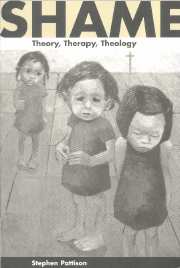Book contents
- Frontmatter
- Contents
- Preface
- Introduction
- PART I APPROACHING SHAME
- PART II ENCOUNTERING SHAME
- Overview of Part II
- 3 The ecology of shame
- 4 Chronic shame
- 5 Some effects and implications of chronic shame
- 6 Aspects of the socio-historical significance of shame
- 7 Dealing with shame: the task of integration
- Summary: towards a working understanding of shame
- PART III SHAME AND CHRISTIANITY
- Epilogue
- Bibliography
- Index
3 - The ecology of shame
Published online by Cambridge University Press: 05 June 2012
- Frontmatter
- Contents
- Preface
- Introduction
- PART I APPROACHING SHAME
- PART II ENCOUNTERING SHAME
- Overview of Part II
- 3 The ecology of shame
- 4 Chronic shame
- 5 Some effects and implications of chronic shame
- 6 Aspects of the socio-historical significance of shame
- 7 Dealing with shame: the task of integration
- Summary: towards a working understanding of shame
- PART III SHAME AND CHRISTIANITY
- Epilogue
- Bibliography
- Index
Summary
He who is ashamed would like to force the world not to look at him, not to notice his exposure. He would like to destroy the eyes of the world. Instead he must wish for his own invisibility.
(Erikson 1965: 244)Shame is a pluriform phenomenon with many implications and ramifications in the discourses in which it appears. Subsequent chapters explore the phenomenology, causes and responses that pertain to a particular kind of shame – chronic, dysfunctional shame. Before focussing on this type of shame, however, it will be useful to place shame in ecological context. This chapter therefore provides preliminary orientation to some important issues and discussions that pertain to shame in general terms. The chapter falls into four discrete sections that each situate shame within a particular kind of conceptual ecology.
In the first section, I try to capture the range of meanings and experiences that seem to be suggested when contemporary people in Western societies talk about shame. The second section of the chapter outlines some of the functions that have been suggested for the phenomenon of shame in individual and social life. It will then be appropriate to look at some of the fundamental distinctions that are made in trying to identify different kinds of shame. One major distinction that is made is that of acute, appropriate shame as distinguished from chronic dysfunctional shame. The last section is then concerned to locate understandings of shame within an appropriate metaphorical ecology. Here I suggest that shame, particularly chronic, dysfunctional shame, is best placed within the broad ecology of meanings that are associated with pollution, stain and defilement.
- Type
- Chapter
- Information
- ShameTheory, Therapy, Theology, pp. 69 - 92Publisher: Cambridge University PressPrint publication year: 2000



